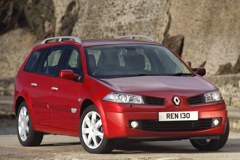Peugeot 307 SW (2002 – 2008) Review
Peugeot 307 SW (2002 – 2008) handling and engines
- Engines range from 1.6 HDi 90 to 2.0 HDi
- Readers report Real MPG to be between 30–70 mpg
Friday 10th February 2006
It was a bit embarrassing being asked to long-term test a facelift Peugeot 307SW when I was already long-terming a Ford C-Max. But it has made for quite a useful comparison.
For a start, the 307SW is a genuine 7-seater. The fact that the centre three seats individually slide as well as double fold means that with a bit of co-operation most families of seven can make sure everyone has enough legroom. At 5 9 I can arrange the seats so I am comfortable in all seven of them.
And thats the 307SWs unique selling proposition. It is now the one and only station wagon with seven forward-facing seats that can comfortably accommodate seven.
It lacks a few things my C-Max has, such as cruise control and optional satnav. Its not as easy to get in and out of. Nor is it quite as comfortable.
However (makes a change from but), Peugeot seems to have been working on the engine.
It should be exactly the same 136PS PSA 16 valve diesel as the C-Maxs. Yet it doesnt feel the same.
Whereas in the C-Max, torque comes in with such a wallop it can spin its front wheels in 2nd, the Peugeot takes its time. And now Ive just about got the engine run-in its proving to be as smooth in its power and torque delivery as the always excellent 1.6 16 valve diesel. Add to that the superb ride quality, the wonderful Peugeot steering feel, and the handling, it really has become a pleasure to drive. And it seems to stretch a gallon of the smelly stuff a bit further than the C-Max too.
Then it blotted its copybook. Okay, Id been in a hurry and Id done what I advise my readers never to do. Id started from cold, driven half a mile and switched off to buy some stop lamp bulbs. Then I started again and drove a mile or so to fit them. Then I started the engine again, third time from cold and depollution system faulty came up on the dash together with a lack of power. I drove through the lack of power, ignored the warning and as soon as I had the engine properly warmed up on the motorway the warning went out.
One thing is for sure: there is not another MPV anywhere in the world that outhandles the 307SW (not even the Mazda 5). It drives, grips and gives even more pleasure than the 307 hatchback. And with the 138PS (136bhp) 2.0 litre 16v HDI its geared to give 35mph per 1,000 rpm in 6th, so you can cruise all day at 90mph and around 2,500rpm. In fact, its so high geared that you need to use lower gears for lesser speeds: 5th is more appropriate for a 50 limit, 4th for 40mph contra-flows, and 3rd for 30mph limits. So while its a fantastic tourer and people mover, with that ultra-tall 6th it probably isnt a very good caravan tower.
Inside, just like an MPV, you get three individual sliding, double-folding, removable centre-rear seats and two folding, removable forward-facing rearmost seats, which are sold as optional extras. Unlike an MPV, you also get a wonderful full-length heat-reflective glass roof that brightens up the interior on a sunny day and can be curtained off with an electric blind when the sun refuses to shine.
Its a 7-seater that goes and handles like a sports car, yet only chucks out 148g/km CO2 and averages 50.4mpg on the combined cycle. And it has the very neat feature of door mirrors which automatically fold when you lock the car. What more could you want?
| Engine | MPG | 0-62 | CO2 |
|---|---|---|---|
| 1.6 16V | 37 mpg | 11.4–11.9 s | 178 g/km |
| 1.6 HDi 110 | 55–57 mpg | 11.5–12.0 s | 131–134 g/km |
| 1.6 HDi 90 | 55–57 mpg | 12.8–13.3 s | 131–134 g/km |
| 2.0 HDi | 50 mpg | 10.8 s | 148 g/km |
Real MPG average for the Peugeot 307 SW (2002 – 2008)

Real MPG was created following thousands of readers telling us that their cars could not match the official figures.
Real MPG gives real world data from drivers like you to show how much fuel a vehicle really uses.
Average performance
94%
Real MPG
30–70 mpg
MPGs submitted
163
Peugeot 307 SW (2002 – 2008) models and specs
| Dimensions | |
|---|---|
| Length | 4428 mm |
| Width | 1762 mm |
| Height | 1580 mm |
| Wheelbase | 2708 mm |
| Miscellaneous | |
|---|---|
| Kerb Weight | 1330–1575 kg |
| Boot Space | 137–1805 L |
| Warranty | 3 years / 60000 miles |
| Servicing | 12000–20000 miles |
| Costs | |
|---|---|
| List Price | £14,500–£19,045 |
| Insurance Groups | - |
| Road Tax Bands | E–I |
| Official MPG | 36.7–56.5 mpg |
| Euro NCAP Safety Ratings | |
|---|---|
| Adult | 4 |
| Child | - |
| Pedestrian | 2 |
| Overall | - |
On sale until April 2008
| Estate | |||
|---|---|---|---|
| Version | List Price | MPG | 0-62 |
| S 1.6 16v | £15,295 | 36.7 mpg | 11.4 s |
| S HDi 110 | £16,995 | 56.5 mpg | 11.5 s |
| S HDi 90 | £16,095 | 56.5 mpg | 12.8 s |
| People Carrier | |||
|---|---|---|---|
| Version | List Price | MPG | 0-62 |
| S 1.6 16v 5dr | £15,545 | 36.7 mpg | 11.9 s |
| S 1.6 HDi 110 FAP 5dr | £17,245 | 55.3 mpg | 12.0 s |
| S 1.6 HDi 90 5dr | £16,345 | 55.3 mpg | 13.3 s |
| SE 1.6 16v 5dr | £16,345 | 36.7 mpg | 11.9 s |
| SE 1.6 16v 5dr Auto | £16,345 | - | - |
| SE 1.6 HDi 110 FAP 5dr | £18,045 | 55.3 mpg | 12.0 s |
| SE 1.6 HDi 90 5dr | £17,145 | 55.3 mpg | 13.3 s |
| SE 2.0 HDi 136 FAP 5dr | £19,045 | 50.4 mpg | 10.8 s |
On sale until November 2006
| Estate | |||
|---|---|---|---|
| Version | List Price | MPG | 0-62 |
| Urban HDi 90 | £14,500 | 56.5 mpg | 12.8 s |
Model History
January 0001
Having given the 307 MPV looks but zero MPV practicality, Peugeot's ace was a stunning 307 station wagon with a full complement of up to seven forward-facing seats, each with their own three-point seat-belts.
The rear five seats all double-fold or remove.
A third of the car's total body area is made of glass making it very light and airy unside. All 307SWs come with a huge 'athermic' glass sunroof which reflects the sun's rays plus standard air conditioning.
(There was also a 307 estate with solid metal roof and fixed rear seat bench.)
Engine choice starts with the 90BHP 2.0 HDI, rising through the 110bhp 1.6 16v, and 110bhp 2.0 HDI, to the 136bhp 2.0 16v. Good looks and seven properly belted seats will sell this car. Prices from £13,660 for five seat 1.6, and from £13,990 for seven seat 1.6.
On sale from April 2002. New DV6 TDE4 1.6 diesel from May 2004. Develops 110bhp at 4,000rpm, 180 lb ft torque at 1,750rpm with overboost to 192 lb ft from Feb 2004 and from May 2004 also new DW10 BTED4 2.0 136bhp diesel with 240lb ft at 2,000rpm and overboost to 250lb ft which is long geared at 35mph per 1,000rpm in 6th. All SWs very good to drive.
Facelift with similar front to 407 from August 2005. New models include 180bhp Feline. Also new EU4 2.0 16v 140bhp petrol engine. 2nd row seats now individually sliding, fully-folding, and removable. 6th and 7th seats remain £199 extras. However the sliding centre row seats transform the car into a genuine 7 seater in which 7 adults up to 5' 9" can travel in reasonable comfort. 2nd row seats are very comfortable. Quality greatly improved from 2006 facelif and the 307SW with 2.0 HDI 136 is superb to drive with excellent handling, roadholding and power delivery.
What to watch out for
Fault in indicator stalks very common on 307s from May 2001. Many owners force and break them. Free fix available in France from December 2002, in UK from 2003 -2004.
Have also been power steering malfunctions.
Reports of rear windows of 307s shattering, possibly due to stress cracks from tailgates being closed from one side.
Clutch failures increasingly common. Clutch judder can develop on 2001/2002 HDIs, caused by wear in internal damper of dual mass flywheel. Needs replacing with modified unit to solve the problem. Dual mass flywheel failure now common on early 2.0HDIs and the flywheels may last only 25,000 miles.
Problem of 1.6 and 2.0 16v diesels slipping into limp home mode put down to throttle butterflies sticking or their spindles wearing prematurely causing them to stick. The throttle position sensor identifies this and sends a message to the ECU to limit the engine to limp home mode.
Can develop a minor wiring harness fault that causes the heater fan resistors to fail.
More reports of turbo oil starvation on 1.6HDI leading to expensive catastrophes. The cure is not just a new turbo, but new oil pipe, pump, pick-up, etc etc. Ford dealer prices for repairs are £1,200 for parts alone. There was a Ford TSB45/2008 about this. Newer engines (2008+) have modified parts. Apparently you can get a new turbo for £350 plus £120 for a "kit" of modified pipes/pick-up unions etc. from Transitpartsuk (International Parts Ltd) to fit next week. eBay supplier TransitpartsUK
09-05-2012:Important to check the drop-down spare wheel cradle mechanism and the jack enclosed in the spare wheel. Jack and mechanism may need greasing or can corrode and seize up. Also check and correct the pressure of the spare tyre.
31-12-2012:'Gong' sound means that car battery is failing to hold sufficient charge and needs to be replaced.
14-08-2018:Various faults appearing on otherwise reliable 2004 Peugeot 307 2.0HDI SW at 114,000 miles: 'Antipolution System Fault' light appeared accompanied with drop in power (limp mode). This warning is ON randomly and intermittantly during a journey, most often there is no warning. Can be on for part of a journey, next trip it is off. Can do 200 miles with it not on sometimes. Owner's code reader said 'Permanent fault P1445' that translated to 'Purge Flow Sensor circuit. High Input'. Might mean the DOF is filling up with ash and needs chemically cleaning by Ceramex. But Peugeot dealer's diagnostics came up with 'Permanent fault stored with Fuel Cap Presence Sensor'. That might be the sensor or might be a badly fitting fuel cap.

.jpg?width=640&height=426&rmode=crop)
.jpg?width=640&height=426&rmode=crop)

.jpg?width=640&height=426&rmode=crop)
.jpg?width=640&height=426&rmode=crop)
.jpg?width=640&height=426&rmode=crop)
.jpg?width=640&height=426&rmode=crop)


 Makes sense of the 307. Up to seven forward-facing seats. Good to drive. Decent diesels.
Makes sense of the 307. Up to seven forward-facing seats. Good to drive. Decent diesels.
 Pre-facelift cars still had quality problems
Pre-facelift cars still had quality problems


.jpg?width=240&height=160&rmode=crop)

.jpg?width=240&height=160&rmode=crop)